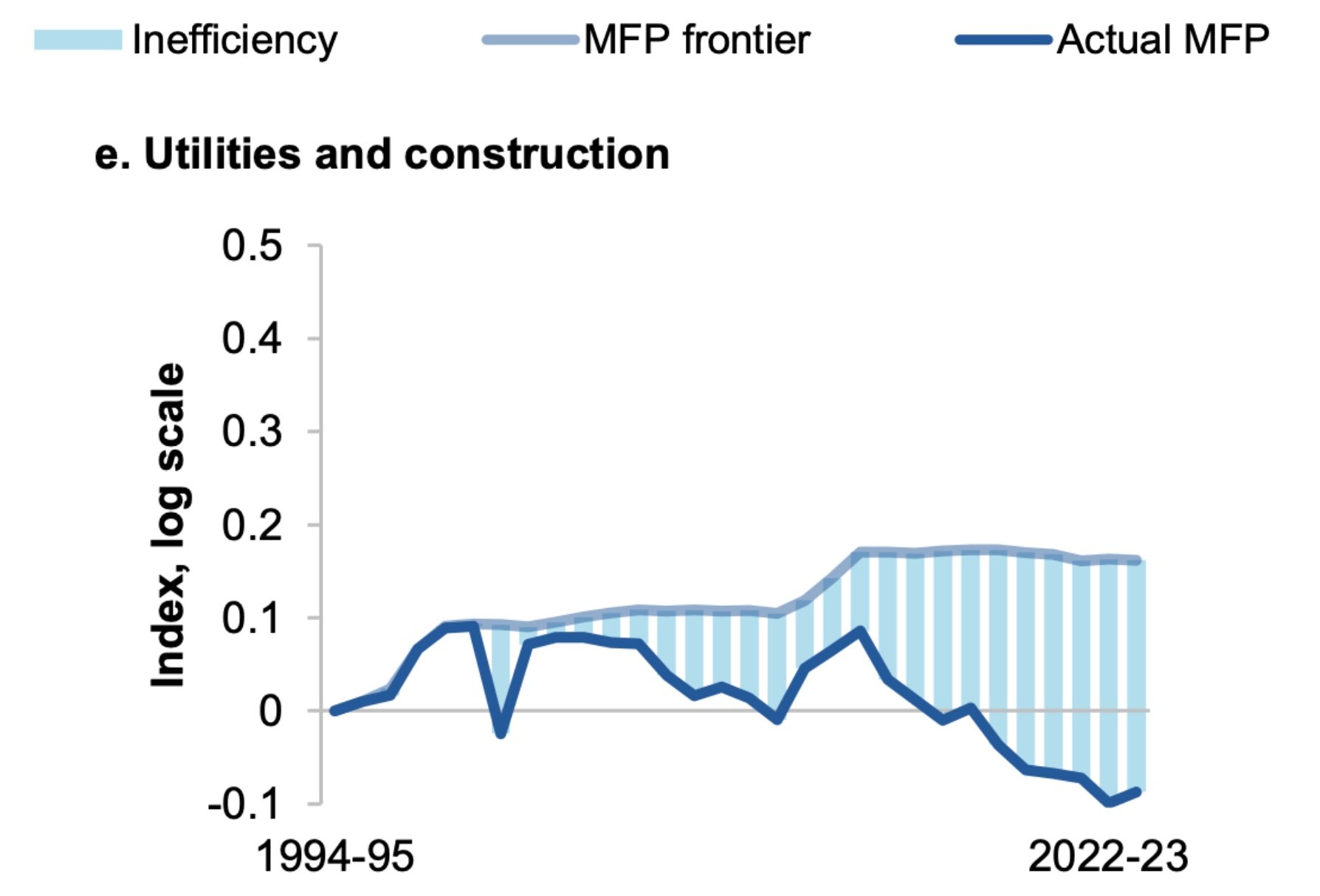Why Australia’s productivity depends on tradies, not just tech
In Australia, the construction industry is supported by the vocational education and training (VET) system, which has a long-standing negative bias when compared to the university system. However, advanced economies such as Australia need to do everything possible to support productivity growth for living standards to keep up with other OECD countries such as the United States, France and Germany. Reforming VET education systems is a way to do this and within the Government's power to execute.
Stagnant productivity growth is an ongoing economic issue in Australia. It limits our ability to increase GDP and living standards. Productivity in the economy is defined as how efficient we are with our inputs (capital and labour) to produce economic outputs. When we talk about productivity, most of the time we imagine technological frontiers and innovation (the internet boom, the adoption of AI, our increasing ability to do remote work). While the adoption of these boundary-pushing technologies does increase productivity, productivity gains can also be found by ensuring all workers are given equal opportunities to access education.
The construction industry is often in the headlines as a particularly poor performer of productivity as it tends to be connected to housing construction and the resulting housing price bubble. The following chart of multi-factor productivity (MFP) shows this declining productivity. MFP is a measure of productivity referring to better ways of combining capital and labour to produce outputs. The MFP frontier is the productivity ceiling due to technological advancements (a theoretical upper limit). In the utilities and construction industries, this has been flat for many years, while in other industries remote work and offshoring have contributed to increases in the MFP frontier. Because actual MFP is falling, the rising gap between actual and frontier MFP represents the increasing inefficiency in this sector.
Multi-factor productivity chart. Source: Australian Productivity Commission, Annual Productivity Bulletin 2025
What is causing this increasing inefficiency gap in the construction sector and what does this have to do with apprenticeships?
Skill and labour shortages are some of the largest contributors to this problem. With the growing number of people enrolling in universities rather than VET, this problem is getting worse. On top of this, there are a number of systemic barriers in the apprenticeship and traineeship system negatively affecting cohorts such as career changers, women and experienced trades workers. Specifically, these barriers include the rigid requirements of apprenticeship contracts, gender discrimination and a low adoption of recognition of prior learning (RPL).
The media often identifies this long-term declining productivity problem and reports on the inefficiencies in the construction sector. Rightly so, they also connect the problem with something Australians feel very deeply about and can easily relate to - the housing crisis. Inefficiency in the construction sector leads to exactly what you might think; less houses being built (lower supply) and therefore higher prices.
Systemic changes are necessary in the VET system, particularly for the construction trades if we want to achieve more apprenticeship completions and more qualified workers. More engagement between the Federal Government and State Governments is needed to ensure that these educational systems are consistent and stronger across all states and territories. In our evaluation work, we have had the opportunity to evaluate a number of programs with these objectives in mind. For example, the Trade Pathways Program came from a direct recommendation from the NSW Productivity Commission. It was focused on creating stronger pathways to trade qualifications for experienced, unqualified workers and women. Both of these groups have traditionally experienced a range of barriers in the vocational training system, such as rigid apprenticeship agreements, low levels of recognition of prior learning (RPL) assessments as well as discrimination and non-inclusivity.
If you are a parent of a high school student - Think about how you portray different education and career paths. You can find more information on VET programs from the NSW Government here and from the Australian Parents Council here.
If you are a career changer - a career in construction or related industries could be different to the stereotypical image of men laying bricks to build houses. Career pathways range from technical trades workers such as carpenters, electricians, engineers, plumbers through to administrative workers such as contract managers and project managers through to other professions such as accounting, design, architecture, landscaping, bush regeneration, demolition or human resources. More on that from the Australian Government here.
If you are a policy maker - Unpack the specific issues, barriers and learn deeply about the problems within society that are holding us back. Engage with industry, employers, students, and others who are critical stakeholders. Design policies and programs with the correct audiences and specific problem statements in mind, which you read about in our other article The missing piece - how designers can transform economic development.
And if you are a decision maker - Addressing the housing crisis cannot happen quickly or easily. Knock on the door of your colleagues and understand how mutually valuable partnerships can be made. For example, planning, housing, employment, economic productivity, education and workplace relations all have a role to play in the housing construction sector. Find out how you can get better at inter-departmental collaboration and long-term strategic planning to make significant inroads into this issue.


